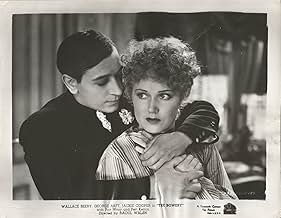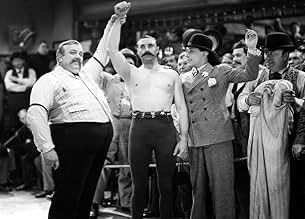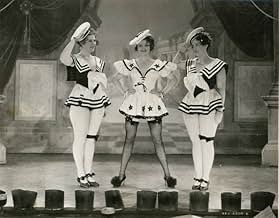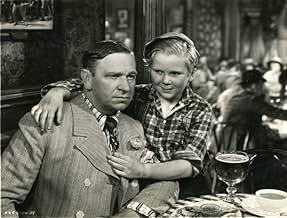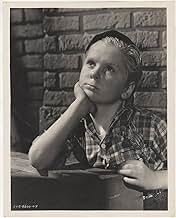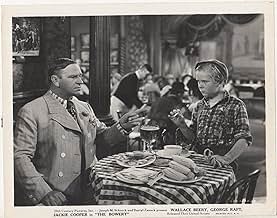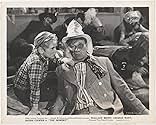Füge eine Handlung in deiner Sprache hinzuIn New York's Bowery during the Gay Nineties, a saloon owner and a rebel share a rivalry.In New York's Bowery during the Gay Nineties, a saloon owner and a rebel share a rivalry.In New York's Bowery during the Gay Nineties, a saloon owner and a rebel share a rivalry.
- Auszeichnungen
- 3 wins total
Bull Anderson
- Pug
- (Nicht genannt)
Irving Bacon
- Hick
- (Nicht genannt)
Lucille Ball
- Blonde
- (Nicht genannt)
John Bleifer
- Mumbo the Mute
- (Nicht genannt)
Phil Bloom
- Pug
- (Nicht genannt)
James Burke
- Recruiting Sergeant
- (Nicht genannt)
Marguerite Caverley
- Undetermined Secondary Role
- (Nicht genannt)
Empfohlene Bewertungen
"The Bowery", along with "Me and My Gal"(1932), is probably director Raoul Walsh's best film at Fox. This is a one Walsh picture that will appeal to all kinds of audiences and perhaps turn you into a devoted Walsh enthusiast. I've always been a big Walsh fanatic and "Bowery" is one of few of his pictures that has eluded for quite some time. I finally saw it and was blown away by it.
"Bowery" is also Walsh's best film of 1933, easily eclipsing the ponderous "Going Hollywood". Inspired by Mae West's hugely successful comedy-riot "She Done Him Wrong", Walsh rightfully turned this pre-Code frolic into his own. All the Walsh touches are here in full bloom: the rousing ebullience & energy, the portrait of everyday life, the sheer innocence of its characters, the nostalgic evocation of the Gay 90s (Walsh's own impressionable years), and the unsophisticated resort to ribald humor, brawls, and jocularity. It also features John L. Sullavan, Errol Flynn's famous opponent in Walsh's 1942 boxing classic "Gentleman Jim".
George Raft and Wallace Beery are excellent as the two rivals in New York's Bowery of the 1890s. They are fighting for the love of Fay Wray (always a welcome sight). Jackie Cooper, playing the streetwise rascal, reunites with Beery after their successful teaming in Vidor's "The Champ" and it is great to watch them again.
Ultimately, though, it is Walsh's sheer exuberance that counts the most. "Bowery" is one of my all-time favorite films, the kind of picture that you would like to watch again and again. A must if you get a chance to see it.
"Bowery" is also Walsh's best film of 1933, easily eclipsing the ponderous "Going Hollywood". Inspired by Mae West's hugely successful comedy-riot "She Done Him Wrong", Walsh rightfully turned this pre-Code frolic into his own. All the Walsh touches are here in full bloom: the rousing ebullience & energy, the portrait of everyday life, the sheer innocence of its characters, the nostalgic evocation of the Gay 90s (Walsh's own impressionable years), and the unsophisticated resort to ribald humor, brawls, and jocularity. It also features John L. Sullavan, Errol Flynn's famous opponent in Walsh's 1942 boxing classic "Gentleman Jim".
George Raft and Wallace Beery are excellent as the two rivals in New York's Bowery of the 1890s. They are fighting for the love of Fay Wray (always a welcome sight). Jackie Cooper, playing the streetwise rascal, reunites with Beery after their successful teaming in Vidor's "The Champ" and it is great to watch them again.
Ultimately, though, it is Walsh's sheer exuberance that counts the most. "Bowery" is one of my all-time favorite films, the kind of picture that you would like to watch again and again. A must if you get a chance to see it.
Four words account for why this film was made - "She Done Him Wrong". The huge commercial success of that Mae West vehicle convinced the studio brass that Gay '90s melodramas were a viable proposition. Here we are rewarded with a fast moving, well written romp which neatly targets the personalities of its stars.
Wallace Beery and George Raft are excellent as friendly rivals; Jackie Cooper is a little harder to take, but it is Fay Wray who steals the film with her stock-in-trade damsel in distress. With a strong director - as Walsh proves himself to be - Wray could carry a lot of punch, and she is utterly believable as the object of both Raft and Beery's affection.
Lots of atmosphere, beautifully designed, this is a forgotten film worthy of revival.
Wallace Beery and George Raft are excellent as friendly rivals; Jackie Cooper is a little harder to take, but it is Fay Wray who steals the film with her stock-in-trade damsel in distress. With a strong director - as Walsh proves himself to be - Wray could carry a lot of punch, and she is utterly believable as the object of both Raft and Beery's affection.
Lots of atmosphere, beautifully designed, this is a forgotten film worthy of revival.
I love this freekin movie! Walsh is a true master of the cinematic form, his film have been sometimes in my opinion, overlooked. But this film is a favourite of mine because it really gives you the feel of the time the film was set in.\
All the wonderful characters that existed, the lifestyle, the mode of dress, the way they spoke, OK they might be exaggerated, but it is good to know that there were occasion when two men tried to outdo each other with insane stunts.
I just felt it was apiece of history thats should be wathced by many people and appreciated because of that fact.
Can I get it somewhere on DVD? I have only seen it on TV. But for anyone wanting a slice of life movie about that period of time this is the perfect one.
All the wonderful characters that existed, the lifestyle, the mode of dress, the way they spoke, OK they might be exaggerated, but it is good to know that there were occasion when two men tried to outdo each other with insane stunts.
I just felt it was apiece of history thats should be wathced by many people and appreciated because of that fact.
Can I get it somewhere on DVD? I have only seen it on TV. But for anyone wanting a slice of life movie about that period of time this is the perfect one.
A favourite of mine,this movie tells of two feuding New York "characters", Steve Brodie(Raft) and "Chuck" Connors(Beery),who both strive to be the "Main Guy" in the Bowery in the late Nineteenth Century.
Brodie(1863-1901) and Connors(1852-1913),were real people,though this is a heavily fictionalized account of their antics(based on a play).Brodie's legendary(did he do it?- it's still a cause of argument!),jump from the Brooklyn bridge(1886),for which he became famous,is shown here as happening around the same time as the Spanish-American war(1898).Director Walsh clearly had a great affection for the period,so beautifully recreated here,and it includes a wild rumbustious ragtime number from saloon singer Trixie Odbray(a young Pert Kelton).Raft is at his slickest as Brodie,and Beery shows again what a clever actor he was,as tough, big hearted, and at times quite touching Connors.Pretty Fay Wray is the love interest both the boys are pursuing.
Full of life and energy,"The Bowery" moves at a fast pace(unlike many early "talkies").It is not an easy movie to find,but is well worth looking out for.
Brodie(1863-1901) and Connors(1852-1913),were real people,though this is a heavily fictionalized account of their antics(based on a play).Brodie's legendary(did he do it?- it's still a cause of argument!),jump from the Brooklyn bridge(1886),for which he became famous,is shown here as happening around the same time as the Spanish-American war(1898).Director Walsh clearly had a great affection for the period,so beautifully recreated here,and it includes a wild rumbustious ragtime number from saloon singer Trixie Odbray(a young Pert Kelton).Raft is at his slickest as Brodie,and Beery shows again what a clever actor he was,as tough, big hearted, and at times quite touching Connors.Pretty Fay Wray is the love interest both the boys are pursuing.
Full of life and energy,"The Bowery" moves at a fast pace(unlike many early "talkies").It is not an easy movie to find,but is well worth looking out for.
In his new 20th Century Pictures Corporation which was at the time releasing its product with United Artists, Darryl F. Zanuck almost had an MGM trifecta for his stars. Wallace Beery and Jackie Cooper came from MGM and Clark Gable almost did. But according to the biography of George Raft from James Parrish, Raft wanted very much to do this film and Zanuck accommodated him and got him from Paramount.
It was a wise move on Zanuck's part because Steve Brodie of the Bowery was a part Raft was born to play. And why not since Raft grew up in the Hell's Kitchen area of New York and knew the scene well.
As did Raoul Walsh who was born and raised in Rockaway Beach, New York and also knew the red light areas of the city well. The best thing that The Bowery has going for it was is the incredible detail in terms of creating the atmosphere of the Gay Nineties in one of New York's most colorful areas. In fact so much detail was presented that the film is rarely seen today for all the racial epithets it has. But that would be true of the era. Racial and ethnic stereotyping was the rule of the day. In fact Ragtime is also quite graphic in that, the difference being the point of view that film takes.
What The Bowery has in atmosphere with its sets, dialog with the idioms of the day, and costumes, it loses in accuracy. Set in 1897-98 before the Spanish American War it has the legendary Steve Brodie doing his jump off the Brooklyn Bridge at that time. In point of fact it was in 1886.
Raft as Brodie and Beery as Chuck Connors are a pair of friendly if caustic rivals of The Bowery area in lower Manhattan. The two are forever trying to top each other and that is given as the reason for Raft doing his famous dive off the Brooklyn Bridge and living to tell about it. Actually there is cause in real life to think Brodie never did the deed. And in fact some question is raised in Beery's mind which leads to the climax of The Bowery.
Jackie Cooper's well known antipathy to Beery has been documented, but in the Parrish book on Raft during a fight scene Beery got a little rougher than the script called for. Raft then responded with what is described as a roundhouse right into the family jewels. Beery reacted normally as one does when one is hit there.
If one values political correctness than do not see this film. But otherwise it is an all too accurate a look on a bygone era.
It was a wise move on Zanuck's part because Steve Brodie of the Bowery was a part Raft was born to play. And why not since Raft grew up in the Hell's Kitchen area of New York and knew the scene well.
As did Raoul Walsh who was born and raised in Rockaway Beach, New York and also knew the red light areas of the city well. The best thing that The Bowery has going for it was is the incredible detail in terms of creating the atmosphere of the Gay Nineties in one of New York's most colorful areas. In fact so much detail was presented that the film is rarely seen today for all the racial epithets it has. But that would be true of the era. Racial and ethnic stereotyping was the rule of the day. In fact Ragtime is also quite graphic in that, the difference being the point of view that film takes.
What The Bowery has in atmosphere with its sets, dialog with the idioms of the day, and costumes, it loses in accuracy. Set in 1897-98 before the Spanish American War it has the legendary Steve Brodie doing his jump off the Brooklyn Bridge at that time. In point of fact it was in 1886.
Raft as Brodie and Beery as Chuck Connors are a pair of friendly if caustic rivals of The Bowery area in lower Manhattan. The two are forever trying to top each other and that is given as the reason for Raft doing his famous dive off the Brooklyn Bridge and living to tell about it. Actually there is cause in real life to think Brodie never did the deed. And in fact some question is raised in Beery's mind which leads to the climax of The Bowery.
Jackie Cooper's well known antipathy to Beery has been documented, but in the Parrish book on Raft during a fight scene Beery got a little rougher than the script called for. Raft then responded with what is described as a roundhouse right into the family jewels. Beery reacted normally as one does when one is hit there.
If one values political correctness than do not see this film. But otherwise it is an all too accurate a look on a bygone era.
Wusstest du schon
- WissenswertesGeorge Raft and Wallace Beery were at odds during filming. According to Raft, before the fistfight scene, Beery asked Raft to let him throw the first punch and then proceeded to sucker-punch Raft, knocking him out for several minutes. "When I came to I got up and called him everything I could think of," Raft said. They then fought for real, and the crew had to break it up.
- PatzerThe name of George Raft's character, "Steve Brodie," is misspelled "Brody" in the opening credits.
- Zitate
Steve Brodie: Don't ever say I never give ya nothin'.
- Alternative VersionenThe version shown on Fox Movie Channel runs seven seconds over 87 minutes. Apparently it is a reissue copy, the missing five minutes due to reediting to fit post code rules. Though it was made for Twentieth Century Films, a new start up film studio organized by Joe Schenck, Bill Goetz (L.B. Mayer's son-in-law) and ex-Warner Bros. production chief Darryl Zanuck, the FMC version is presented under the post merger logo of Twentieth Century Fox complete with fanfare and an end title crediting distribution to TCF. This year a full uncut version was shown at New York's Film Forum which clocked several minutes over ninety minutes.
- VerbindungenEdited into Brooklyn Bridge (1981)
- SoundtracksThe Bowery
(uncredited)
Music by Percy Gaunt
Lyrics by Charles Hale Hoyt
Sung by a chorus at the beginning
Played often in the score
Top-Auswahl
Melde dich zum Bewerten an und greife auf die Watchlist für personalisierte Empfehlungen zu.
- How long is The Bowery?Powered by Alexa
Details
Box Office
- Budget
- 421.496 $ (geschätzt)
- Laufzeit1 Stunde 32 Minuten
- Farbe
- Seitenverhältnis
- 1.37 : 1
Zu dieser Seite beitragen
Bearbeitung vorschlagen oder fehlenden Inhalt hinzufügen

